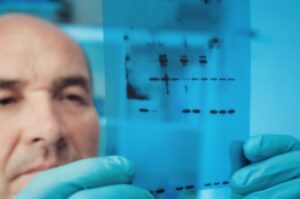EXPRESSION ASSAY DEVELOPMENT: ELISA VS WESTERN BLOT

ELISA and western blotting are similar in several respects. Both depend on immunological reactions between antigens and antibody. Both assays utilize proteins immobilized to solid supports and both usually use enzymatic detection systems.
- Preparation of cell or tissue extracts that retain the relevant properties of the analyte.
- Fractionation/enrichment and immobilization of analyte to a solid matrix.
- Specific detection of the analyte.
There are a variety of cell extraction methods suitable for use with both western blotting and ELISA. They consist of cell disruption using physical or chemical methods or both. These methods include sonication and dounce or French press homogenization. Physical disruption serves to disrupt cells and release cellular components to increase the efficiency protein solubilization. Typically, physical disruption is followed by chemical extraction.
Chemical extraction involves the use of detergent to solubilize proteins. The extent of target protein extraction can be optimized by the type and concentration of detergent used. For example, sodium dodecyl sulfate (SDS), will result in complete cell lysis that will denature and destroy the biological activity, of most proteins. This is a good detergent for preparation of total cell proteins for western blot analysis. On the other hand detergents such as NP-40, Triton X-100 and digitonin are used to solubilize proteins in their biologically active state. In addition, conditions can be optimized to selectively extract components from specific cellular organelles or subcellular compartments. This allows the target protein to be selectively solubilized leading to a reduction in nonspecific background and, importantly, increases sensitivity of the assay.
There are additional factors that influence the efficiency of extraction while maintaining the suitability of the target protein for detection. These include the ionic strength of the buffers that is adjusted by the type and concentration of ionic components (i.e. salts) used. Ionic strength effects the stringency of the antibody binding and can greatly influence non-specific binding that can contribute to background noise. Higher ionic strength buffers favor high specificity protein binding interactions. However, they can also lead to loss of specific signals as well.
When beginning a project it is necessary to systematically optimize conditions to ensure specific and reproducible results. Request formal project quotation from Altogen Labs CRO.
ELISA
Enzyme-linked immunosorbent assays (ELISAs) are a common test to quantify antibody or antigen binding activity. For more detail, see our ELISA page.
WESTERN BLOT
The Western blot is a standard technique used to quantify the amount of target protein produced by a cell. For more detail, see our Western Blotting page.
STABILITY ANALYSIS
In addition, various techniques can be used to assess the stability of proteins produced. For more detail, see our Stability Analysis page.
Request formal project quotation from Altogen Labs CRO.
Laboratory Services │ Science Of Protein Expression │ Protein Expression Applications │ Assay Developmen │ ELISA │ Western Blot │ Stability Analysis │ Available Services